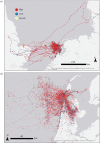Flap or soar? How a flight generalist responds to its aerial environment
- PMID: 27528785
- PMCID: PMC4992719
- DOI: 10.1098/rstb.2015.0395
Flap or soar? How a flight generalist responds to its aerial environment
Abstract
The aerial environment is heterogeneous in space and time and directly influences the costs of animal flight. Volant animals can reduce these costs by using different flight modes, each with their own benefits and constraints. However, the extent to which animals alter their flight modes in response to environmental conditions has rarely been studied in the wild. To provide insight into how a flight generalist can reduce the energetic cost of movement, we studied flight behaviour in relation to the aerial environmental and landscape using hundreds of hours of global positioning system and triaxial acceleration measurements of the lesser black-backed gull (Larus fuscus). Individuals differed largely in the time spent in flight, which increased linearly with the time spent in flight at sea. In general, flapping was used more frequently than more energetically efficient soaring flight. The probability of soaring increased with increasing boundary layer height and time closer to midday, reflecting improved convective conditions supportive of thermal soaring. Other forms of soaring flight were also used, including fine-scale use of orographic lift. We explore the energetic consequences of behavioural adaptations to the aerial environment and underlying landscape and implications for individual energy budgets, foraging ecology and reproductive success.This article is part of the themed issue 'Moving in a moving medium: new perspectives on flight'.
Keywords: GPS; accelerometer; foraging ecology; orographic lift; soar; thermal convection.
© 2016 The Author(s).
Figures



Similar articles
-
Energetic influence on gull flight strategy selection.J Exp Biol. 2006 Sep;209(Pt 18):3489-98. doi: 10.1242/jeb.02385. J Exp Biol. 2006. PMID: 16943489
-
Remotely sensed wind speed predicts soaring behaviour in a wide-ranging pelagic seabird.J R Soc Interface. 2017 Jul;14(132):20170262. doi: 10.1098/rsif.2017.0262. J R Soc Interface. 2017. PMID: 28701505 Free PMC article.
-
Built up areas in a wet landscape are stepping stones for soaring flight in a seabird.Sci Total Environ. 2022 Dec 15;852:157879. doi: 10.1016/j.scitotenv.2022.157879. Epub 2022 Aug 6. Sci Total Environ. 2022. PMID: 35944643
-
Evolution of avian flight: muscles and constraints on performance.Philos Trans R Soc Lond B Biol Sci. 2016 Sep 26;371(1704):20150383. doi: 10.1098/rstb.2015.0383. Philos Trans R Soc Lond B Biol Sci. 2016. PMID: 27528773 Free PMC article. Review.
-
Into rude air: hummingbird flight performance in variable aerial environments.Philos Trans R Soc Lond B Biol Sci. 2016 Sep 26;371(1704):20150387. doi: 10.1098/rstb.2015.0387. Philos Trans R Soc Lond B Biol Sci. 2016. PMID: 27528777 Free PMC article. Review.
Cited by
-
Less is more: On-board lossy compression of accelerometer data increases biologging capacity.J Anim Ecol. 2020 Jan;89(1):237-247. doi: 10.1111/1365-2656.13164. J Anim Ecol. 2020. PMID: 31828775 Free PMC article.
-
Simultaneous GPS-tracking of parents reveals a similar parental investment within pairs, but no immediate co-adjustment on a trip-to-trip basis.Mov Ecol. 2021 Aug 21;9(1):42. doi: 10.1186/s40462-021-00279-1. Mov Ecol. 2021. PMID: 34419142 Free PMC article.
-
Physiological mechanisms underlying animal social behaviour.Philos Trans R Soc Lond B Biol Sci. 2017 Aug 19;372(1727):20160231. doi: 10.1098/rstb.2016.0231. Philos Trans R Soc Lond B Biol Sci. 2017. PMID: 28673909 Free PMC article.
-
Barrier crossings and winds shape daily travel schedules and speeds of a flight generalist.Sci Rep. 2021 Jun 8;11(1):12044. doi: 10.1038/s41598-021-91378-x. Sci Rep. 2021. PMID: 34103580 Free PMC article.
-
Time and energy costs of different foraging choices in an avian generalist species.Mov Ecol. 2019 Dec 30;7:41. doi: 10.1186/s40462-019-0188-y. eCollection 2019. Mov Ecol. 2019. PMID: 31908778 Free PMC article.
References
-
- Norberg UM. 1990. Vertebrate flight: mechanics, physiology, morphology, ecology and evolution. Berlin, Germany: Springer.
-
- Hedenström A. 2002. Aerodynamics, evolution and ecology of avian flight. Trends Ecol. Evol. 17, 415–422. (10.1016/S0169-5347(02)02568-5) - DOI
-
- Dudley R. 2002. The biomechanics of insect flight: form, function, evolution. Princeton, NJ: Princeton University Press.
MeSH terms
Associated data
LinkOut - more resources
Full Text Sources
Other Literature Sources

